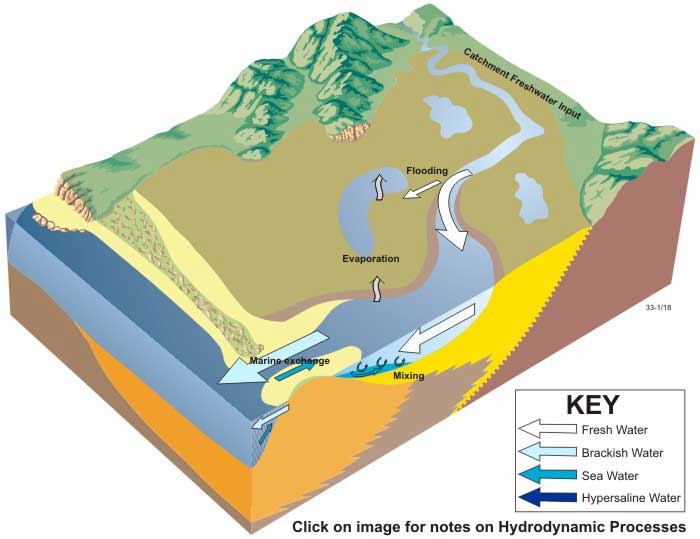
Hydrology processes in wave-dominated deltas
1. Freshwater input
Freshwater enters from the catchment. Although the volume of freshwater input varies regionally and seasonally (depending on local catchment and climatic conditions), it is typically relatively high in most deltas.
2. Fresh water inundation of low-lying areas
Floods, or high runoff events, driven by climatic and catchment processes, can result in the inundation of low-lying swamp and marsh areas by fresh water. This water often supports freshwater wetland ecosystems, and typically is either taken up by vegetation, or evaporates. Many wave-dominated deltas are more prone to flooding, due to relatively high freshwater input and relatively low total volume (compared to estuaries and embayments).
3. Freshwater flow
The volume of freshwater may cause significant stratification within the channel, which varies with seasonal flow. Current flow in channels is strong, due to their small relative volume, and the consequent short residence time of water (the time taken for water to travel through the delta). Due to the small water volume, floods may completely force marine water out of the delta.
4. Salt wedge inflow of more dense seawater
A ‘salt-wedge’, or intrusion of denser saline marine water penetrates the delta through the entrance (which is usually open on a permanent basis). Wave-dominated deltas are generally characterised by limited tidal intrusion because of friction effects and the relatively strong river flow. Some mixing occurs at the interface between the less-dense freshwater, and higher-density marine water. The distance that the salt-wedge penetrates is dependant on tidal range and the amount of fluvial flow received by the delta (Kurup et al., 1998). During high fluvial flow events (which may be seasonal), fresh floodwater rapidly pushes the salt water intrusion seaward (beyond the mouth), completely removing stratification from the delta (Hossain et al., 2001, Eyre, 1998).
5. Large outflow to brackish water
Exchange of sea water and river water occurs through the entrance of the delta, depending on the width of the entrance channel. In deltas, the net outflow of catchment-derived river water typically exceeds the inflow of marine water.
6. Minor evaporation
Due to the relatively low surface area of most wave-dominated deltas, evaporation is a minor component (depending on climatic conditions) and does not exceed river input.


